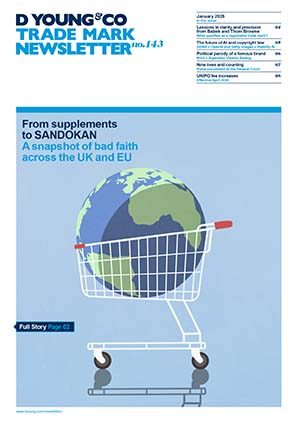The neutralisation principle: Board of Appeal overturns EUIPO decision
CFL Australia Pty Ltd (the applicant) applied for the mark GOTCHA, covering a range of goods (tea, coffee, snacks, etc) and services (snack bars, etc). Gong Cha Global Ltd (the opponent) operates a chain of bubble tea restaurants around the world, and filed an opposition to the application on the basis of its GONG CHA marks covering an array of similar and identical goods/services.
First instance decision
At first instance, the European Union Intellectual Property Office (EUIPO) rejected the opposition on the basis that:
- Visually and aurally, the marks are similar to a below average degree.
- GOTCHA has a meaning for English speakers.
- Where at least one of the signs at issue has a clear and specific meaning, the resulting conceptual differences may offset the visual and aural similarities between the signs (the so-called “neutralisation principle”).
- Consequently, there was no likelihood of confusion and the opposition was rejected.
Appeal
Gong Cha Global appealed, arguing that whilst conceptual similarities must be taken into account when making the overall assessment, neutralisation can only be applied exceptionally, and it is only a part of the overall assessment. The global appreciation of the marks as a whole is what is important. CFL Australia disagreed, highlighting the aural, visual and conceptual differences between the two marks, and asserted that the neutralisation principle should be applied here as the conceptual differences are enough to counteract the aural and/or visual similarities.
Decision
Given the unitary character of the European Union trade mark (EUTM), an earlier mark can be a basis for opposition even if it only relates or applies to consumers in part of the EU. Therefore, the Board of Appeal focused on the Polish speaking part of the relevant public. In redoing the global assessment, the Board of Appeal found:
- GONG CHA as a whole does not have any meaning in Polish and is therefore normally distinctive.
- GOTCHA also does not have any meaning in Polish so is normally distinctive.
- The marks are visually similar to an average degree.
- Phonetically, the marks differ only in the pronunciation of the middle letters “NG” verses “T”. They are therefore aurally similar to a high degree.
- Given that both marks are meaningless, the conceptual comparison is neutral.
The Board of Appeal held that it could not follow the approach of the EUIPO, and found that there would be a likelihood of confusion: the appeal was allowed.
Neutralisation principle
On the neutralisation principle, the Board of Appeal held that this refers to the situation where a particularly pronounced and obvious conceptual difference between the signs at issue may counteract any visual and phonetic similarity.
However, in the case at hand:
- The earlier sign GONG CHA does not convey any clear and obvious meaning, therefore the neutralisation principle could not apply.
- In at least part of the EU, the sign GOTCHA also would not convey any clear and obvious meaning.
Thus the conceptual differences were not enough to neutralise the visual and phonetic similarities in this particular case.
Comment
The Board of Appeal reasoned that the neutralisation principle could not apply here for two reasons:
- Not all of the relevant public would grasp the conceptual meaning of the opposed mark; and
- The earlier sign, as a whole, had no conceptual meaning, which means that the conceptual differences were not sufficient to neutralise the visual and aural similarities.
The first reason makes sense: although it is not clear on what evidence the Board of Appeal was basing its views, as the decision merely asserts that the Polish speaking public would not understand the term GOTCHA (which may well be correct). For neutralisation to apply, the meaning of the sign must be clear and specific for the entire public for whom the signs are visually and phonetically similar.
The second reason seems to be a nuanced departure from previous practice. The EUIPO Guidelines suggest that the neutralisation principle can be applied if one of the signs has a clear and specific meaning that can be grasped immediately by the relevant public. The Board of Appeal’s decision here seems to be heavily based on the fact that one of the signs did not have a conceptual meaning.
In any event, it appears for now at least that the neutralisation principle will remain the exception rather than the rule.
Case details at a glance
Jurisdiction: EU
Decision level: Board of Appeal
Parties: Gong cha Global Ltd v CFL Australia Pty Ltd
Date: 12 May 2025
Citation: R 2191/2024-2
Decision: dycip.com/euipo-gotcha-may2025

